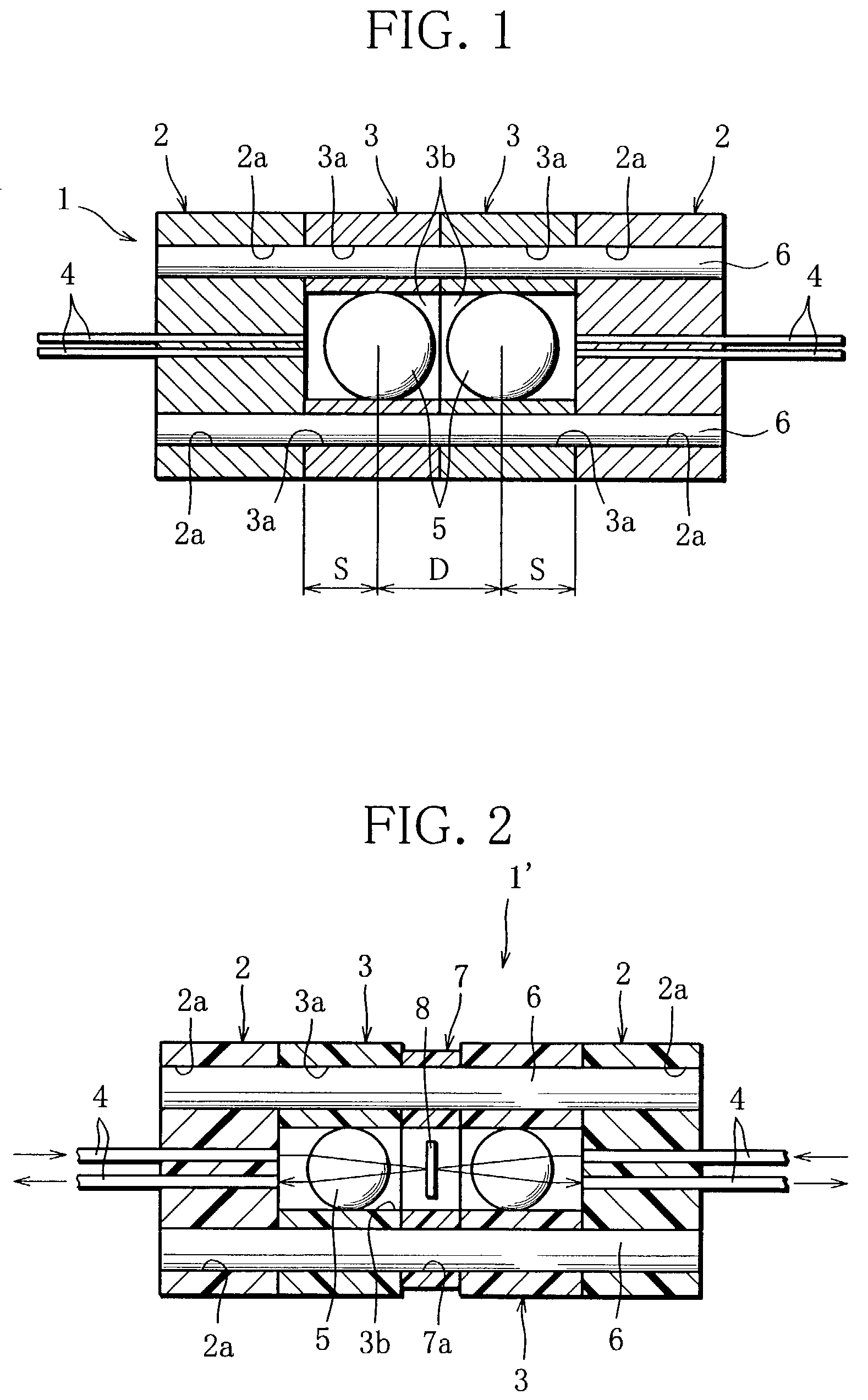Optical module, and multi-core optical collimator and lens housing therefor
a technology of optical collimators and lenses, applied in the field of optical modules, can solve the problems of easy difficult to always apply a minute amount of adhesive to the lens, and mechanical damage to the fiber end faces, etc., to prevent deterioration of light sources, increase insertion loss, and facilitate separation
- Summary
- Abstract
- Description
- Claims
- Application Information
AI Technical Summary
Benefits of technology
Problems solved by technology
Method used
Image
Examples
first embodiment
[0129]With reference to FIGS. 3–5, an optical module according to the present invention will be explained in detail.
[0130]This optical module 10 comprises a first fiber unit 20 in which distal end portions of two pairs of optical fibers F11–F14 are fixedly arranged in parallel to the longitudinal direction (AB direction) of the optical module 10; a second fiber unit 30 in which distal end portions of two pair of optical fibers 21–24 are fixedly arranged in parallel to the AB direction; a first collimator unit 40 having a lens Ls for collimating outgoing light beams from the optical fibers F11–F14 of the first fiber unit 20; a second collimator unit 50 having a lens L2 for collimating outgoing light beams from the optical fibers F21–24 of the second fiber unit 30; a pair of guide pins 60 for positioning the units 20, 30, 40 and 50 to one another; clips 70 for fixedly holding these units 20, 30, 40 and 50. The first fiber unit 20 and the first collimator unit40 constitute a first mult...
third embodiment
[0153]In the following, an optical module will be explained.
[0154]As shown in FIG. 9, this optical module 210 comprises a first ferrule 220 serving as a fiber unit in which two pairs of optical fibers F11–F14 (FIG. 11) are fixed in parallel to the optical axis; a second ferrule 230 serving as another fiber unit in which two pairs of optical fibers F21–F24 (FIG. 11) are fixed in parallel to the optical axis; a first lens section 240 having a first lens L1 for collimating outgoing light beams from the optical fibers F11–F14 of the first ferrule 220; a second lens section 250 having a second lens for collimating outgoing light beams from the optical fibers F21–F24 of the second ferrule 230; a holder 280, disposed between the first and second lens sections 240, 250, for holding a band pass filter 282; and a casing 260 for receiving the elements 220, 230, 240, 250 and 280. The first ferrule 220 and the first lens section 240 constitute a first multi-core collimator, whereas the second f...
fourth embodiment
[0168]Next, with reference to FIGS. 14A and 14B, an operation of the optical module will be explained.
[0169]In a case where a mirror 81 is not inserted between collimator units 40, 50 as shown in FIG. 14A, a laser light beam from an outer optical fiber F31 in the first fiber unit 20 is coupled to an outer optical fiber F44 in the second fiber unit 30, which fiber is disposed diametrically opposite the optical fiber F31, whereas a laser light beam from an inner optical fiber F32 is coupled to an inner optical fiber F43 disposed diametrically opposite the optical fiber F32. The laser light beams from the optical fibers F31, F32 are accurately collimated through the first lens L1, cross the center axis CA, and are accurately focused to end faces of optical fibers F44, F43 through the second lens L2. On the other hand, in a case where the mirror 81 is inserted between the collimator units 40, 50 as shown in FIG. 14B, a laser light beam from the outer optical fiber F31 of the first fibe...
PUM
 Login to View More
Login to View More Abstract
Description
Claims
Application Information
 Login to View More
Login to View More - R&D
- Intellectual Property
- Life Sciences
- Materials
- Tech Scout
- Unparalleled Data Quality
- Higher Quality Content
- 60% Fewer Hallucinations
Browse by: Latest US Patents, China's latest patents, Technical Efficacy Thesaurus, Application Domain, Technology Topic, Popular Technical Reports.
© 2025 PatSnap. All rights reserved.Legal|Privacy policy|Modern Slavery Act Transparency Statement|Sitemap|About US| Contact US: help@patsnap.com



